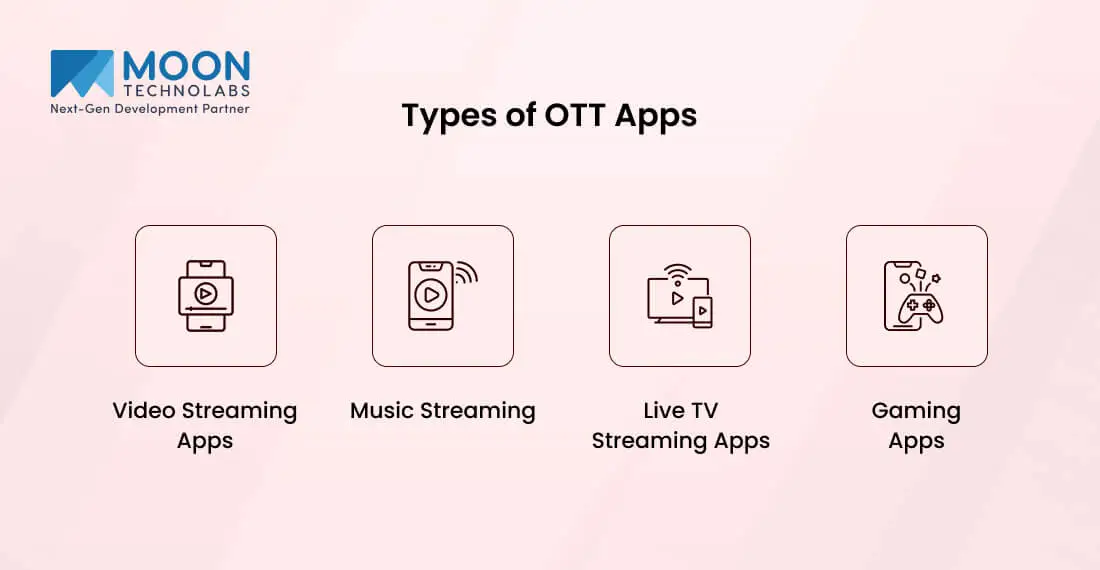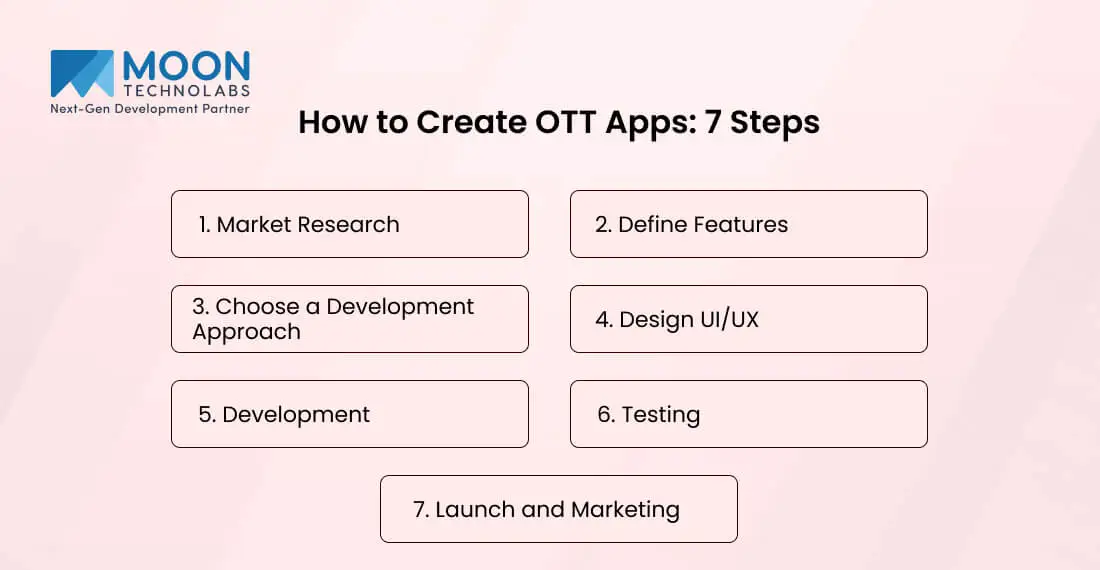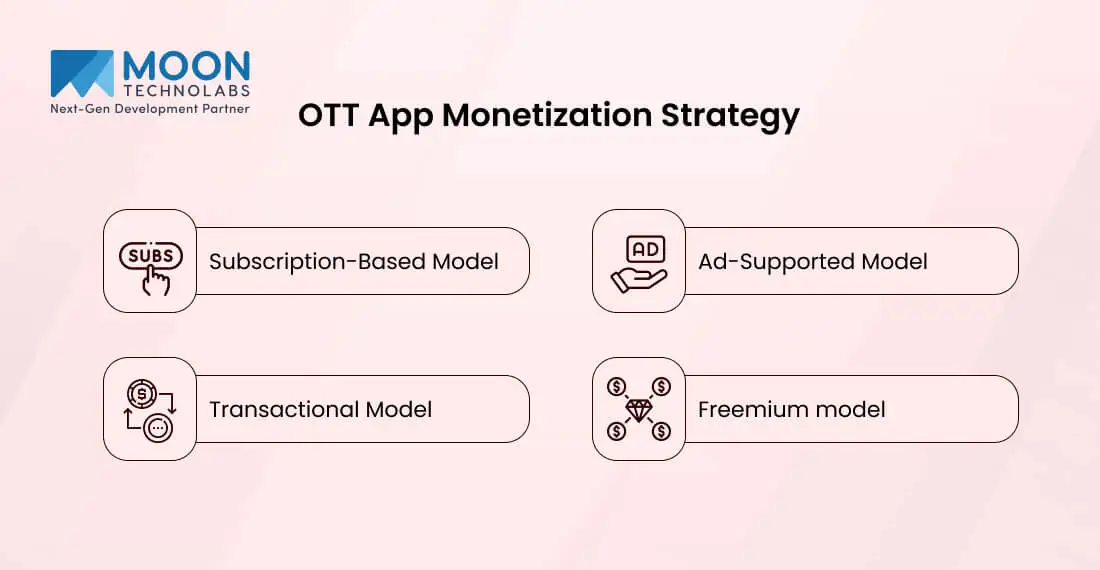Table of Content
Blog Summary:
This post serves as a complete guide for OTT app development. Whether you wish to know the development steps, features, or monetization strategies, you can explore everything here. It helps you complete your OTT app development journey successfully while streamlining the process and getting the desired outcomes.
Table of Content
As per stats, the OTT video market is expected to reach up to $316.40bn in 2024. The overall revenue is likely to witness an annual growth rate of 6:30% (CAGR 2024-2029), which results in a projected market volume of $429.40bn by the year 2029.
The above stats may have excited you, especially if you are looking for an innovative business idea. These stats also suggest that OTT app development is one of the most profitable business ideas, and it can help you earn hefty revenue even in the long term.
So, if you are looking to develop your own OTT application, now is the time to act and unlock the missed revenue generation opportunities.
Before you actively engage in OTT app development, it’s essential to explore crucial information, including steps, features, etc. In this post, we will discuss everything. Let’s explore.
OTT applications have emerged as the latest form of entertainment and thus tantalized many people’s senses. The major reason for their growing popularity is their ability to cater to the changing needs and preferences of people, especially those who are digitally savvy.
Let’s look at some of the valid reasons why OTT apps are so popular or why you should develop them.
Traditional forms of entertainment, such as television, are losing their relevance due to the immense growing popularity of OTT mobile apps. These apps provide the convenience of on-demand content and enable users to watch based on their preferences and time.
Whether watching newly released movies or missed episodes of any favorite series, OTT platforms allow users to access their favorite content conveniently. Thus, they have emerged as a good option for people who are busy with hectic schedules or seek to redefine their entertainment experience.
One of the major advantages of OTT applications is that they allow users to access vast libraries of content in different languages, genres, and formats.
Whether users wish to watch a documentary or a popular movie featuring their favorite stars, they have the flexibility to access a range of content. They can watch the content from anywhere with an internet connection.
One of the top reasons why OTT apps are popular is their advanced recommendation algorithms, which can analyze user behavior, preferences, viewing history, etc. Based on these, the platform delivers a personalized recommendation. It suggests content based on individual tastes.
OTT platforms improve user experience and thus ensure long-term engagement. Intuitive content discovery interfaces make it convenient for users to explore several new titles according to their interests.
OTT applications allow users to enjoy accessing and watching content irrespective of the devices they use. This platform provides an amazing flexibility for content consumption. With the use of these applications, users can stream their favorite movies and shows on a range of devices, including tablets, smartphones, gaming consoles, smart TVs, and more.
So, the multi-device compatibility ensures a seamless transaction between different screens. It enables users to start watching their favorite shows where they left off, regardless of their location or the device at hand.
There are different types of OTT applications. Each of the apps serves some specific purpose to cater to the diverse needs of users. Let’s understand some of the most popular types of OTT apps.

Many popular video streaming applications, such as Hulu and Netflix, have witnessed their vast download and installation rates. Users can access these streaming apps to access a variety of content, including TV shows, movies, documentaries, and more.
With the video streaming platform, users can discover their new shows based on their convenience. These apps have redefined the way users consume content by letting them enjoy personalized viewing even without the constraints of traditional TV schedules.
While searching for the best music streaming apps, you will come across numerous options. Apple Music and Spotify are two of those. These music streaming apps have transformed the way people enjoy music. They have extensive catalogs of songs from different genres.
With the help of music streaming apps, users can get access to a large number of tracks. Music streaming applications are also available with many features, such as curated recommendations, personalized playlists, offline listening, etc.
Live TV streaming apps like YouTube TV, Sling TV, and others cater to mainly those who still wish to enjoy only live TV channels.
These applications provide a great selection of live broadcasts, including news, sports, entertainment channels, and more. Live TV streaming applications allow users to watch their favorite TV programs in real-time or record them for later viewing.
Any platform is incomplete without gaming. OTT platform also caters to game lovers with services such as Google Stadia, PlayStation Now, and others.
With these gaming platforms, users can stream their video games directly to their devices without any need for expensive gaming consoles or high-end PCs. Gamers can leverage cloud gaming technology to access a wide range of titles and play them quickly, regardless of their hardware capabilities.
Get in touch with our experts to share your OTT app ideas.
Connect with Us
Well, developing OTT applications involves several steps. So, if you plan to create your OTT app, it’s crucial to understand the different phases of building it.

Research is the first process of developing an OTT application. Thorough market research helps you understand your target audience, their preferences, and various competitive landscapes.
The development team closely reviews the existing platforms to identify gaps and opportunities for innovation. Other factors, such as content offerings, user experience, and subscription models, can also be considered.
After completing the research work, it’s now time to define the core features and functionality of your OTT application. It’s something that may include several features like personalized recommendations, user profiles, content categorizations, multi-device synchronizations, offline viewing, social sharing capabilities, and more.
Make sure your OTT app includes all the necessary features to align with your target audience’s needs and preferences.
The next step is choosing the right development approach for your OTT application. You can decide whether to build it from scratch or use existing app development platforms.
If you opt for building from scratch, you can customize your app more, but it also requires time and resources. Leveraging various pre-built solutions can accelerate the app development process but minimize flexibility.
A seamless UI/UX design is pivotal to ensure the complete success of your OTT applications. Designers craft visually enticing interfaces that are easy to navigate and thus witness higher user engagement.
You should focus on several factors, such as playback controls, content discovery, and accessibility across different screen sizes and devices.
After the design process is completed, the development team will proceed with development, which is the crucial phase of creating an OTT app.
You need to ensure that your application is compatible with different operating systems and devices. You can also create a powerful backend infrastructure for superuser management, content delivery, and analytics.
QA experts conduct thorough testing of the newly developed OTT application to find bugs or performance issues before they launch it. You can conduct thorough testing across multiple devices, network conditions, screen sizes, etc.
You can also test many features, including content loading times, video playback, payment processing, and user authentication.
After completing the testing and resolving all issues, it’s time to launch your OTT application. You can submit your application to app stores like Google Play Store and Apple App Store based on the type of application you have.
Once you submit your application to the app store, it’s time to launch a marketing campaign to generate buzz and lure users to your platform.
You can formulate an effective marketing strategy to attract a maximum number of clients. Your marketing campaign strategy should also include discounts, promotions, or free trials.
For an effective marketing campaign, you can also utilize various channels like influencer partnerships, email marketing, social media, targeted advertising, and more to reach your target customers.
Features are one of the most crucial factors that play a vital role in your OTT app MVP success. Let’s discuss here some of the top features that your OTT app MVP should include.
Your OTT application should offer seamless onboarding, which is vital for user retention. Your MVP should also offer secure registration methods, such as contact numbers, emails, social media log-ins, etc.
In addition, you can integrate some powerful authentication measures to prevent users’ data from entering the wrong hands.
Your MVP should include content in different genres and categories, as well as various curated playlists for easy and smooth navigation. You can use certain intuitive UI/UX designs to improve user experience. It enables users to discover new content even without putting in much effort.
You can integrate a robust search algorithm into your MVP to let users find certain specific titles quickly. You can also use ML algorithms to offer personalized recommendations based on viewing history, user preferences, behavior patterns, and more.
You can organize your OTT application for smooth audio/video playback with adaptive technology to accommodate different internet speeds.
Make sure your MVP is compatible with multiple formats and resolutions to provide top-quality content across multiple devices.
You can provide an offline download function to serve users with limited internet access or those who seek to watch content on the go. This function allows users to download their preferred movies or shows for later viewing, even without an internet connection.
You can allow users to create various personalized profiles to customize their viewing experience. Make sure your OTT app MVP allows users to create watchlists and preferences, as well as manage their viewing history, which improves a sense of ownership and control.
You should integrate various social sharing options into your MVP to foster social interaction. It allows users to recommend content to their friends. You can integrate various other features, such as enhanced engagement, likes, comments, and more.
Make sure your MVP ensures a seamless transition between different devices by implementing multi-device synchronization.
You can permit users to pause their playback on one device and then resume it on another without losing their progress, which provides a convenient viewing experience.
Push notifications inform users about the latest news related to new launches, special offers, personalized recommendations, and more. You can utilize behavior data and user preferences to send targeted notifications, which improves user engagement.
You can improve both trust and transparency by letting users rate and also review their content properly. You can aggregate user feedback to improve content curation and various recommendation algorithms, which improves the quality of the viewing experience.
You can integrate a fully secure payment gateway to allow subscription-based or also pay-per-view models. It’s advisable to offer a plethora of payment options to attract more users and boost engagement. It also provides seamless transactions by streamlining the overall user subscription process.
You are suggested to gather a full insight into content performance, user behavior, and app usage with the help of analytics and also reporting dashboards.
You can analyze several important metrics, such as retention rates, user engagement, content popularity, and more. These are useful for making data-driven decisions and can also optimize platforms.
Developing an OTT application provides you with numerous earning opportunities. To earn money, you need to create the most effective monetization strategy that can help you earn money for a long time.

Let’s explore some of the top monetization strategies for your OTT application.
One of the most frequently used methods for monetizing OTT apps is the subscription-based model, which enables users to access content for a recurring fee, generally for a month or an annual period.
Many leading services, such as Amazon Prime Video and Netflix, implement this strategy by offering a range of content without ads in exchange for a subscription fee. This strategy allows you to provide engaging content that can retain subscribers and attract new ones.
Users can access content for a fee, but advertisements that appear during viewing time are paid. So, in this model, OTT app owners earn mainly through advertisements.
Many popular platforms, such as YouTube, Hulu, and others, have already adopted this model of advertisement. These OTT apps are available with free and premium subscription options.
Also popular as pay-per-view, transactional models allow users to pay for individual pieces of content or access various specific events. OTT app platforms like Google Play Movies and iTunes use this model to rent or purchase movies and TV shows.
The success of the transactional model mainly depends on the most sought-after content that users seek to pay for on a one-time basis.
The hybrid approach combines mainly ad-supported content with subscription-based and premium features. Users can access basic content for free, especially while several additional perks or exclusive content are unlocked through subscription.
LinkedIn and Spotify are top examples of implementing this monetization strategy. It offers both free access with ads and also premium subscriptions for add-free with improved features.
It’s time to develop your own OTT application with Us
Contact Us
The cost of OTT App Development ranges from $60,000 to $500,000. The cost can even go beyond this based on the type of OTT application with multi-platform compatibility, top-quality video streaming, etc.
Many other factors, such as platforms, features, complexity, etc., also impact the OTT development cost.
Apart from this, some other factors that influence OTT app development costs include content licensing fees, maintenance updates, and more. To streamline the cost of an OTT app without compromising quality, you can conduct thorough market research and engage with experienced developers.
You need to plan appropriately before diving into OTT application development. After going through the above discussion, you have now understood the process of creating an OTT application. It helps you chalk out the right strategy and then proceed accordingly to create the application.
The most important thing you need to do is partner with an experienced OTT app development company and industry experts to bring our OTT app idea to life. You can discuss your app development requirements in depth with them and ask them for suggestions as well.
01
02
03
04
Submitting the form below will ensure a prompt response from us.